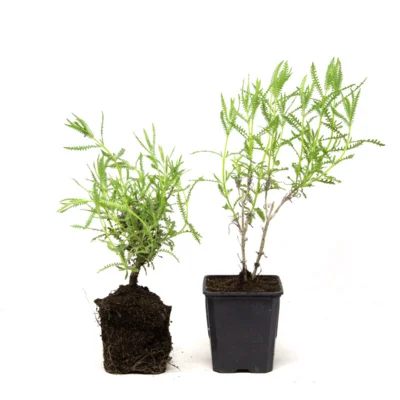
Lavender lace 2 organic plants
Welcome these organic plants of toothed lavender, also known as fringed lavender or English lavender, both in the garden and in pots. Easy to grow, this hardy perennial can exceed 70 cm in height. It forms a beautifully rounded mass, lined with slender, strongly toothed, aromatic ash-green leaves. It blooms with a multitude of blue-purple flowers, grouped in a terminal spike, which are particularly fragrant.
Discover how to grow this precious aromatic and medicinal plant in the garden or in pots, in any space, and enjoy its elegance and intoxicating fragrance.
How to grow toothed lavender
Toothed lavender is planted in spring, from April to May, in the open ground after the last frosts, or in a large pot. It can be grown on its own or in hedges, flowerbeds or rock gardens.
Choose a sunny exposure and favor light, well-drained soil, even poor, stony soil. In heavy soils, add gravel or sand for good drainage. Transplant at 40 to 60 cm in all directions and water abundantly after planting.
Prune back faded flower stems every year at the end of August, after flowering.
Prune a second time in March to give your lavender a more compact form. Avoid pruning an old lavender plant that has been neglected for several years too short, as it won't thrive on old wood.
How do I take cuttings of toothed lavender?
Take toothed lavender cuttings at the end of summer, between mid-August and early September, to easily multiply your plants:
- Fill a planter, pot or cups with a mixture of potting soil and sand;
- remove lateral branches, about 20 cm long, without wood;
- remove the leaves from two-thirds of the lower part of each stem;
- cut off the tips of the terminal leaves with a chisel, to limit evaporation;
- plant the cuttings, up to the first leaves, in groups of 3 or 4;
- press the soil firmly around the cuttings;
- water;
- shelter the cuttings in a bright spot;
- keep them moist until you take them again.
To facilitate root formation, soak the basal end of each cutting in a solution of natural cutting hormone. This is easily prepared by cutting small sections of willow and leaving them to macerate overnight in a little water.
Toothed lavender: benefits and uses
Like true lavender, the flowering tops of toothed lavender are harvested during flowering and offer a host of benefits. Rich in essences, they have antioxidant, antidiabetic, antispasmodic, antidiarrheal, antiparasitic, antihypertensive, antibacterial, antifungal, anti-inflammatory and other properties.
Traditionally, toothed lavender has been used to relieve various pathologies such as diabetes, inflammation and microbial infections.
Like other lavenders, it is consumed as a herbal tea, infusion, essential oil or mother tincture.
Shipping and delivery of the Companion Plants assortment
- Orders are dispatched Monday to Thursday.
- Delivery to mainland France only.
- Shipping cartons designed for optimum plant protection.
- Free shipping does not apply to plants.






